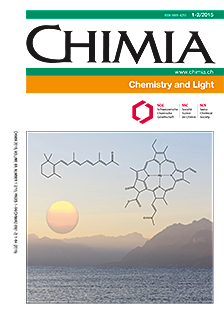Dye-sensitized Solar Cells: New Approaches with Organic Solid-state Hole Conductors
DOI:
https://doi.org/10.2533/chimia.2015.41Keywords:
Conducting polymer, Dye, Hole conductor, Mesoporous oxide, Solar cellAbstract
Solid-state dye-sensitized solar cells (sDSCs) in which a solid organic charge-transfer medium, or hole conductor (HC), is interposed between a dye-coated mesoporous oxide electrode and a conductive counter electrode, have attracted considerable interest as viable alternatives to the more ubiquitous mediator-electrolyte DSC. Of particular importance to efficient operation are, in addition to the useful processes contributing to current generation (light harvesting, electron injection and current collection), the recombinative deleterious processes. The organic HCs are highly reactive toward electrons in the oxide or the conducting glass support, therefore necessitating the inclusion of a carefully prepared thin blocking oxide underlayer support as well as the molecular design of special dark current-suppressing dyes. Initially (mid-1990s) sDSCs with organic small molecular weight hole conductors have undergone systematic investigation. At the same time the first tests of sDSCs with conducting polymer hole conductors were published, with subsequent emphasis on the in situ generation of the HC inside the pores. For both types of devices a light-to-electricity conversion efficiency, in the 5-10% range for several dye-HC combinations, approaches that of the most efficient DSCs with non-volatile liquid electrolytes, thereby encouraging further efforts for obtaining stable, efficient and inexpensive sDSCs.Downloads
Published
2015-02-25
How to Cite
[1]
N. Vlachopoulos, J. Zhang, A. Hagfeldt, Chimia 2015, 69, 41, DOI: 10.2533/chimia.2015.41.
Issue
Section
Scientific Articles
License
Copyright (c) 2015 Swiss Chemical Society

This work is licensed under a Creative Commons Attribution-NonCommercial 4.0 International License.







